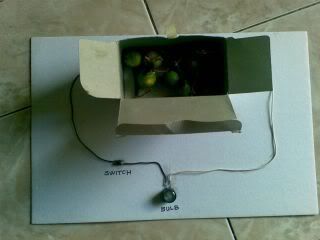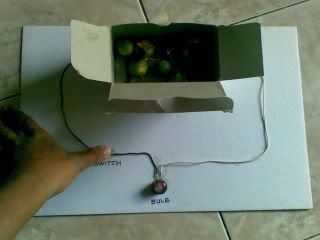Calamansi if I'm not mistaken is translated as Philippine lemon in English. It is used in cooking, in making sauces or dips, juice for lemonade, medicine for cough, etc. What I did is a strange application for calamansi.

The circuit is composed of 1 LED (light emitting diode), 1 pushbutton switch, the calamansi battery and wires off course. Everything is held together either by quick setting glue or solder. The base used is a piece of illustration board while the small box used to contain some electronic gadgets transferred elsewhere. When the button is pressed, the LED should light up as shown in the picture.

So how come those calamansi was able to light up the LED?
Normally, a battery has two electrodes, one negative and one positive. The third element is the electrolyte. For our battery, I used 1 inch iron nails as negative electrodes and solid copper wire cuts (about 2 inches) as positive electrodes. Now it should be obvious that calamansi would serve as our electrolyte.
To create a single cell, a single calamansi gets a nail and copper wire pair pressed into it. Each cell generates about half a volt which is not enough to light up the LED. I ended up with 7 cells connected in series. The LED started to glow with about 5 cells and I added two more to make it brighter. I don't know how much current this battery can produce but it will not be so much. That's for sure!
With 7 cells, the open-circuit voltage of the calamansi battery is 3.2V. It drops when loaded to about 1.6V which is more or less the forward bias voltage for the LED.

The circuit is composed of 1 LED (light emitting diode), 1 pushbutton switch, the calamansi battery and wires off course. Everything is held together either by quick setting glue or solder. The base used is a piece of illustration board while the small box used to contain some electronic gadgets transferred elsewhere. When the button is pressed, the LED should light up as shown in the picture.

So how come those calamansi was able to light up the LED?
Normally, a battery has two electrodes, one negative and one positive. The third element is the electrolyte. For our battery, I used 1 inch iron nails as negative electrodes and solid copper wire cuts (about 2 inches) as positive electrodes. Now it should be obvious that calamansi would serve as our electrolyte.
To create a single cell, a single calamansi gets a nail and copper wire pair pressed into it. Each cell generates about half a volt which is not enough to light up the LED. I ended up with 7 cells connected in series. The LED started to glow with about 5 cells and I added two more to make it brighter. I don't know how much current this battery can produce but it will not be so much. That's for sure!
With 7 cells, the open-circuit voltage of the calamansi battery is 3.2V. It drops when loaded to about 1.6V which is more or less the forward bias voltage for the LED.
pwede po ba pag calamansi extract ang gagamitin?
ReplyDeleteI think pwede naman. But remember, you need to have several cells in series for the LED to light up.
ReplyDeleteHow can calamansi produce electricity?
ReplyDeleteIn: Electricity and Magnetism [Edit categories]
Answer:
simply because it has citric acid
Thanks for the comment Christian.
DeleteYes. Normally, it is an acid that is being used as the electrolyte.
Automotive batteries for example are also called lead-acid batteries.
How to make that calamansi circuit?
ReplyDeletetanga nan
Deletecan i ask? whats your real name please. we just need it for our research project? plsss. thank you
ReplyDeletecan i ask? whats your real name please. we just need it for our research project? plsss. thank you
ReplyDeletecan i ask? whats your real name please. we just need it for our research project? plsss. thank you
ReplyDeleteIs it possible for calamansi to charge a phone battery??
ReplyDeleteAnd what is your real name??(just needed in our research project)
If you connect it directly, the answer is NO.
Delete